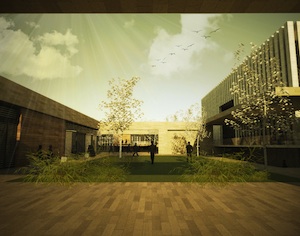By: Maryam Eskandari
Last week, the Chicago based nonprofit organization, Faith in Place, announced its winner for “Building: Problem or Solution?” competition. 26 design firms, representing 11 states, and six countries participated. Of which, the winner for this year was a team of four young Muslims, from Pasadena, California whose winning entry was the Sustainable Green Mosque. The Sustainable Green Mosque played on the notion of weaving the sustainability concept, along with the traditional mosque elements, into a modern urban context.
Faith in Place, an organization “that gives religious people the tools to become good stewards of the earth,” called out for the international competition in order to develop an array of design concepts that would create congregational spaces that are both active and vibrant throughout the week. Faith in Place wanted to challenge the designers to push the boundaries on religious congregations, which are “often saddled with outdated structure designed for an earlier period”, and many communities just emulate these structures. Thus, the challenge was that the new designed spaces that would be generated would have to be sustainable, eco-friendly, and serve not only the religious needs of the community, rather it the most important criteria was that it would bring the users of the religious space along with serving the broader community with in the building was to be residing on.
Team 42, the Sustainable Green Mosque, which was lead by designers Onat Oktem, Ziya Imren, Zeynep Oktema and Uri Tzarnotzky, incorporated different programming functions into the Green Mosque for the “Freestanding Religious Structure” category. Besides the traditional main building and prayer space, the mosque was programmed to include a library, and a lecture hall. However, the unique space that has been incorporated is the ‘soup kitchen’. This singular architectural programming is a brilliant vocabulary that all American mosques should incorporate, allowing for a social and cultural exchange that the current society is yearning for. The soup kitchen would prepare meals for those who are in need, by using products as corn, onions and potatoes that would be from the garden which is integrated into the mosque complex.
The products of the vegetable garden would be easy to develop in Wisconsin’s climate, since it would require little amount of water. However, Wisconsin’s humid climate is the perfect condition for the two of the utmost basic sustainable features: solar energy, rainwater harvesting and waste water management. For example, on the dome of the mosque, solar thermal cells units are inclined and carefully composed for water heating purposes. The library, soup kitchen and lecture hall are capped with green roofs, to not only mitigate the heat island effect, but to also improve air quality, and help cool off the vicinity of the mosque.
A thermal buffer zone is created through the masses of the building. The double- hall system helps the mosque not only insulate itself from the noise, and create a calm environment for the prayer area; rather it creates a thermal buffer zone between the interior and the exterior. The execution of this system allows for a steady climate to be kept within the space. Internal heating in the winter protects the interior from snow, wind and rain. On the other hand, the double thermal buffer zone also creates a cooling zone in the main mass during the summer months.
Rainwater and wastewater management is highly embraced in this mosque design. Clearly, a mosque requires more water, for ablution purposes before the prayer, in comparison to other religious buildings. Hence, in order to alleviate the utilization of water, rainwater and wastewater from the ablution are collected, purified, re-used and piped through a high-efficiency irrigation system, for watering the vegetable garden. While some of the water is used for toilets. Waterless urinals, low-flow faucets and water-efficient plumbing fixtures are integrated within the design to reduce water consumption.
Along with the use of solar energy and rainwater harvesting, the team decided to choose the construction materials that where of recycled contents. For instance, the paint, adhesive and sealants that where suggested where “low chemical emissions.” Local materials reduce the transportation cost, and the energy that is spent on delivering the product while supporting the local industry. Thus, these kinds of contribution assist to the overall design goal – sustainability, becoming “good stewards of the earth” and perhaps reminding all of us the building might not be the problem, rather it might the solution.
Images: courtesy of www.faithinplace.org




















Comments